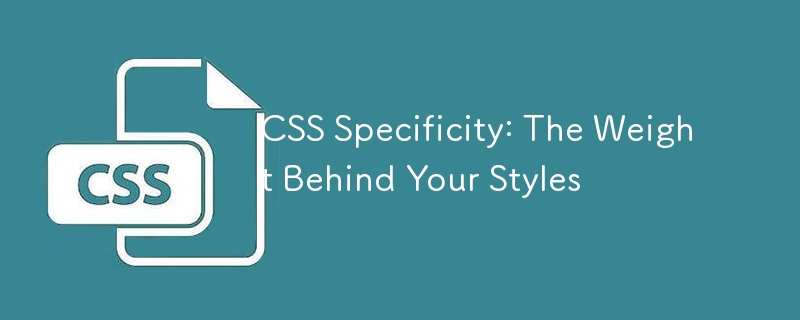CSS Specificity: The Weight Behind Your Styles

Introduction
Imagine CSS as a fashion show where different styles compete for attention. The winner? The style with the most "weight" or specificity. In this post, we'll unravel the mystery behind CSS specificity, explaining how it works and why it matters.
Understanding CSS Specificity
Specificity is a numerical value assigned to each CSS selector. It determines which style rule wins when multiple styles are applied to the same element. Think of it as a fashion contest where the most stylish outfit takes the spotlight.
How to Calculate Specificity
Specificity is calculated based on four factors:
- Inline styles: Styles directly applied to an element using the style attribute. These have the highest specificity (1, 0, 0, 0).
- IDs: Selectors using the #id syntax. Each ID contributes 100 points (0, 1, 0, 0).
- Classes, attributes, and pseudo-classes: Selectors using .class, [attribute], or :pseudo-class contribute 10 points each (0, 0, 1, 0).
- Elements and pseudo-elements: Selectors targeting elements (like p, div) or pseudo-elements (like ::before, ::after) contribute 1 point each (0, 0, 0, 1).
Example:
- #my-id .my-class:hover has a specificity of (0, 1, 1, 0) or 110 points.
- .my-class p has a specificity of (0, 0, 1, 1) or 11 points.
The rule with the highest specificity wins.
The Impact of Specificity
- Overriding styles: More specific selectors can override less specific ones. For example, an inline style will always override a style defined in a stylesheet.
- Unintended consequences: High specificity can make it difficult to override styles, leading to unexpected results.
- Debugging: Understanding specificity helps pinpoint style conflicts and resolve them efficiently.
Real-world Examples
Let's say you have a button with the following styles:
button {
color: blue;
}
.primary-button {
color: red;
}
#important-button {
color: green;
}
If the button has the classes primary-button and the ID important-button, the green color from the ID will be applied because it has the highest specificity.
Conclusion
CSS specificity can be a complex topic, but understanding it is crucial for mastering CSS. By grasping how specificity is calculated and its impact on style application, you'll be better equipped to create well-structured and predictable styles.
In the next post, we'll dive deeper into CSS layers, a powerful tool for managing specificity and improving your CSS architecture.
The above is the detailed content of CSS Specificity: The Weight Behind Your Styles. For more information, please follow other related articles on the PHP Chinese website!

Hot AI Tools

Undresser.AI Undress
AI-powered app for creating realistic nude photos

AI Clothes Remover
Online AI tool for removing clothes from photos.

Undress AI Tool
Undress images for free

Clothoff.io
AI clothes remover

Video Face Swap
Swap faces in any video effortlessly with our completely free AI face swap tool!

Hot Article

Hot Tools

Notepad++7.3.1
Easy-to-use and free code editor

SublimeText3 Chinese version
Chinese version, very easy to use

Zend Studio 13.0.1
Powerful PHP integrated development environment

Dreamweaver CS6
Visual web development tools

SublimeText3 Mac version
God-level code editing software (SublimeText3)

Hot Topics
 1664
1664
 14
14
 1423
1423
 52
52
 1317
1317
 25
25
 1268
1268
 29
29
 1242
1242
 24
24
 Google Fonts Variable Fonts
Apr 09, 2025 am 10:42 AM
Google Fonts Variable Fonts
Apr 09, 2025 am 10:42 AM
I see Google Fonts rolled out a new design (Tweet). Compared to the last big redesign, this feels much more iterative. I can barely tell the difference
 How to Create an Animated Countdown Timer With HTML, CSS and JavaScript
Apr 11, 2025 am 11:29 AM
How to Create an Animated Countdown Timer With HTML, CSS and JavaScript
Apr 11, 2025 am 11:29 AM
Have you ever needed a countdown timer on a project? For something like that, it might be natural to reach for a plugin, but it’s actually a lot more
 HTML Data Attributes Guide
Apr 11, 2025 am 11:50 AM
HTML Data Attributes Guide
Apr 11, 2025 am 11:50 AM
Everything you ever wanted to know about data attributes in HTML, CSS, and JavaScript.
 A Proof of Concept for Making Sass Faster
Apr 16, 2025 am 10:38 AM
A Proof of Concept for Making Sass Faster
Apr 16, 2025 am 10:38 AM
At the start of a new project, Sass compilation happens in the blink of an eye. This feels great, especially when it’s paired with Browsersync, which reloads
 How We Created a Static Site That Generates Tartan Patterns in SVG
Apr 09, 2025 am 11:29 AM
How We Created a Static Site That Generates Tartan Patterns in SVG
Apr 09, 2025 am 11:29 AM
Tartan is a patterned cloth that’s typically associated with Scotland, particularly their fashionable kilts. On tartanify.com, we gathered over 5,000 tartan
 How to Build Vue Components in a WordPress Theme
Apr 11, 2025 am 11:03 AM
How to Build Vue Components in a WordPress Theme
Apr 11, 2025 am 11:03 AM
The inline-template directive allows us to build rich Vue components as a progressive enhancement over existing WordPress markup.
 While You Weren't Looking, CSS Gradients Got Better
Apr 11, 2025 am 09:16 AM
While You Weren't Looking, CSS Gradients Got Better
Apr 11, 2025 am 09:16 AM
One thing that caught my eye on the list of features for Lea Verou's conic-gradient() polyfill was the last item:
 A Comparison of Static Form Providers
Apr 16, 2025 am 11:20 AM
A Comparison of Static Form Providers
Apr 16, 2025 am 11:20 AM
Let’s attempt to coin a term here: "Static Form Provider." You bring your HTML




